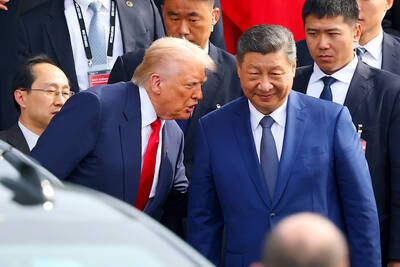The US Department of State has approved the sale of US$228 million of military goods and services to Taiwan, the US Department of Defense said on Monday.
The state department “made a determination approving a possible Foreign Military Sale” to the Taipei Economic and Cultural Representative Office in the US for “return, repair and reshipment of spare parts and related equipment,” the defense department’s Defense Security Cooperation Agency said in a news release.
Taiwan had requested the purchase of items and services which include the “return, repair and reshipment of classified and unclassified spare parts for aircraft and related equipment; US Government and contractor engineering, technical and logistics support services; and other related elements of logistics and program support,” the statement said.

Photo: Lo Pei-de, Taipei Times
“The sale is consistent with US law and policy as expressed in Public Law 96-8,” the release said, referring to the Taiwan Relations Act.
The US Congress, which is expected to approve the sale, has already been notified, the agency said.
In Taipei, the Ministry of Foreign Affairs thanked the US government for “upholding Taiwan’s safety in accordance to the Taiwan Relations Act and the ‘six assurances.’”
The Ministry of National Defense also expressed its gratitude for the approved purchase.
“The Chinese Communist Party’s normalization of gray zone intrusions are putting pressure on training space and reaction times in Taiwanese waters and airspace,” the defense ministry said in a statement.
The aviation-related goods and services “will help maintain the combat readiness and safety of various types of aircraft equipment of our air force,” it added.
It is the 16th time that US President Joe Biden’s administration has authorized the sale of military goods and services to Taiwan, the defense ministry said.
Presidential Office spokesperson Karen Kuo (郭雅慧) said in a statement that the sale reflects the importance placed by the Biden administration on peace and stability in the Taiwan Strait, and the continued implementation of US security commitments to Taiwan.
The Presidential Office backed up the defense ministry’s comment by saying that the sale would help maintain the combat readiness of the air force to deal with “normalized gray zone intrusions” by the Chinese People’s Liberation Army (PLA).
Meanwhile, a US Navy aircraft flew through the Taiwan Strait yesterday in what the US called a show of commitment to free and open international airspace, prompting China to scramble fighters.
“By operating within the Taiwan Strait in accordance with international law, the United States upholds the navigational rights and freedoms of all nations,” the US 7th Fleet said of the P-8A Poseidon’s flight.
The Eastern Theater Command of the PLA said jets were scrambled to monitor and “alert” the US aircraft.
Last week, two German navy ships sailed through the Taiwan Strait in the first such transit in two decades in a show of Berlin’s resolve to stand with Western allies over Taiwan.
Additional reporting by Reuters

CALL FOR SUPPORT: President William Lai called on lawmakers across party lines to ensure the livelihood of Taiwanese and that national security is protected President William Lai (賴清德) yesterday called for bipartisan support for Taiwan’s investment in self-defense capabilities at the christening and launch of two coast guard vessels at CSBC Corp, Taiwan’s (台灣國際造船) shipyard in Kaohsiung. The Taipei (台北) is the fourth and final ship of the Chiayi-class offshore patrol vessels, and the Siraya (西拉雅) is the Coast Guard Administration’s (CGA) first-ever ocean patrol vessel, the government said. The Taipei is the fourth and final ship of the Chiayi-class offshore patrol vessels with a displacement of about 4,000 tonnes, Lai said. This ship class was ordered as a result of former president Tsai Ing-wen’s (蔡英文) 2018

UKRAINE, NVIDIA: The US leader said the subject of Russia’s war had come up ‘very strongly,’ while Jenson Huang was hoping that the conversation was good Chinese President Xi Jinping (習近平) and US President Donald Trump had differing takes following their meeting in Busan, South Korea, yesterday. Xi said that the two sides should complete follow-up work as soon as possible to deliver tangible results that would provide “peace of mind” to China, the US and the rest of the world, while Trump hailed the “great success” of the talks. The two discussed trade, including a deal to reduce tariffs slapped on China for its role in the fentanyl trade, as well as cooperation in ending the war in Ukraine, among other issues, but they did not mention

HOTEL HIRING: An official said that hoteliers could begin hiring migrant workers next year, but must adhere to a rule requiring a NT$2,000 salary hike for Taiwanese The government is to allow the hospitality industry to recruit mid-level migrant workers for housekeeping and three other lines of work after the Executive Yuan yesterday approved a proposal by the Ministry of Labor. A shortage of workers at hotels and accommodation facilities was discussed at a meeting of the legislature’s Transportation Committee. A 2023 survey conducted by the Tourism Administration found that Taiwan’s lodging industry was short of about 6,600 housekeeping and cleaning workers, the agency said in a report to the committee. The shortage of workers in the industry is being studied, the report said. Hotel and Lodging Division Deputy Director Cheng

‘SECRETS’: While saying China would not attack during his presidency, Donald Trump declined to say how Washington would respond if Beijing were to take military action US President Donald Trump said that China would not take military action against Taiwan while he is president, as the Chinese leaders “know the consequences.” Trump made the statement during an interview on CBS’ 60 Minutes program that aired on Sunday, a few days after his meeting with Chinese President Xi Jinping (習近平) in South Korea. “He [Xi] has openly said, and his people have openly said at meetings, ‘we would never do anything while President Trump is president,’ because they know the consequences,” Trump said in the interview. However, he repeatedly declined to say exactly how Washington would respond in